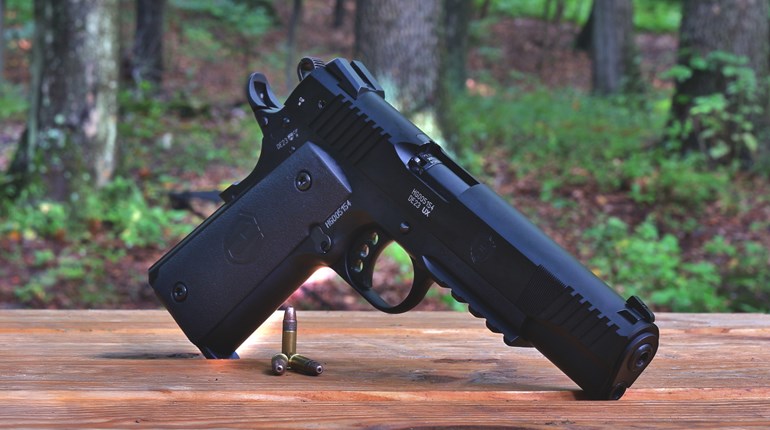
The Aguila MiniShell slug load contains a 378-grain, solid-lead slug. Recoil is a bit more than the buckshot load, but still quite comfortable.
Aguila means eagle in Spanish. Aguila ammunition is manufactured in Mexico, in a plant originally set up by Remington in 1961. The company is the primary supplier of ammunition to the Mexican military and one of the world’s largest producers of rimfire ammunition. Aguila ammunition comes across the border and is distributed in the U.S. exclusively through Texas Armament & Technology in Houston, TX. Some shooters have never heard of Aguila, but many rimfire shooters relish it.
This is because Aguila manufacturers rimfire ammunition using Eley technology, and any serious shooter knows the name. It’s also because Aguila offers a wide range of rimfire ammo; some of the company’s loads are very distinctive in makeup. For centerfire, Aguila offers the usual suspects with regard to handgun ammo and several military-caliber loads. The company also manufactures a full range of shotshells. The most unique and innovative are its MiniShells.

Aguila MiniShells are very short 12-gauge shells with an overall length of only 1.34 inches. That’s almost 1.5 inch shorter than a standard 2¾-inch shotshell. Only three loads are available: 7 1⁄2 shot rated at 1,175 fps, buckshot rated at 1,250 fps and a slug at 1,250 fps. Aguila provided samples of its buckshot and slugs to test.
The buckshot load is listed as “00,” but in reality it’s not. It contains 11 pellets. Four of the 11 measure .293 inch in diameter and seven mic out at .237 inch. These are actually the sizes of No. 1 and No. 4 buck, respectively. True 00-buck pellets measure .33 inch in diameter. At any rate, these 11 pellets make up a payload weighing 279 grains, which is, as Aguila advertises, a 5⁄8-ounce load.
I tested the Mini-Shot duplex load in a Mossberg 590A1 Magpul shotgun, which has a nine-shot capacity, but is capable of holding 14 MiniShells. This was immediately inspiring, but when I attempted to cycle the action I ran into problems. Holding the shotgun vertically, I had a failure to fully cycle rate of about nine out of 10. Holding the shotgun horizontally, cycling the action as you would when shooting, reliability was much better with only about one failure in every 10. For absolute best reliability, you had to cycle the shotgun with a rhythm, making the 590A1 a less-than-ideal pairing for the truncated shells.
When fired, at 10 yards was about what you would expect from a defensive shotshell load; patterns averaged in the 10-inch range. This equates to about 1 inch per yard, which is reasonably common out of a cylinder-bore barrel. However, when the range was extended by only 5 more yards, the pattern size more than doubled, with some patterns exceeding 2 feet. These are, without question, short-range defensive loads. However, their undeniable beauty was what could only be described as a total lack of recoil from the 8-pound shotgun.
The slug load utilizes a solid-lead projectile that weighs 384 grains and measures .693 inch in diameter. It has a shortened nose and a hollow base filled with a solid-plastic wad. These shells fed much more reliably. Working the action with the shotgun horizontal, I didn’t have a single failure to cycle. I suspect the slugs fed better because of their weight and distribution. Both the shotshells and the slugs exhibited 100-percent extraction and ejection.
Shooting the slugs, I produced five-shot groups at 25 yards, which averaged between 4 and 8 inches. (In some cases it was a little hard to tell, because the wad carried all the way to the 25-yard target, making a hole identical in size to the slug.) No, these are not match-grade shotgun slugs, and you would be ill advised attempting a precision shot much past 10 yards. The recoil was also noticeably stiffer than the buckshot load but still more than manageable. I would compare it to that of a .410-bore slug.
The obvious question is why would anyone want to shoot such a short shotgun shell. The answer is simple: It provides greater capacity with less recoil. The problem I encountered with the Mossberg pertained to reliability, and a defensive shotgun must be—if nothing else—100-percent reliable. However, in another shotgun, reliability might be much better. Associates report excellent performance in the Kel-Tec KSG as well as the Winchester Model 1300. Selling for less than $1 a shell, MiniShells are certainly worth trying.
Where I can see these MiniShells really standing out is in a compact double-barrel defensive shotgun like Mossberg’s Maverick where cycling is not an issue. This is a gem of a defensive shotgun weighing only 6 pounds and measuring only 36 inches long. It will get your attention with full-power loads, but should be quite comfortable when loaded with the MiniShells. If you have folks in your home who are seriously recoil sensitive, the Maverick/Aguila MiniShell combination could provide an adequate threat-stopping defensive arm with which they are comfortable and proficient.
While Aguila MiniShells may have some compatibility concerns, they work and fill a necessary niche. Whether you’re recoil sensitive or simply looking for inexpensive plinking fodder that is versatile—and loads of fun—to shoot, Aguila’s innovative offerings are not only an option; they are a really good and practical alternative. More importantly, their ammo is beneficial for everyone.


































